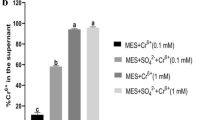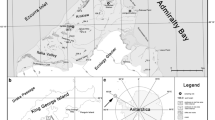Abstract
In this study we performed a phylogenetic analysis of a culturable bacterial community isolated from heavymetal-contaminated soil from southwest Slovakia using 16S rRNA (16S rDNA) and heavy-metal resistance genes. The soil sample contained high concentrations of nickel (2,109 mg/kg), cobalt (355 mg/kg) and zinc (177 mg/kg), smaller concentrations of iron (35.75 mg/kg) and copper (32.2 mg/kg), and a trace amount of cadmium (<0.25 mg/kg). A total of 100 isolates were grown on rich (Nutrient agar No. 2) or minimal (soil-extract agar medium) medium. The isolates were identified by phylogenetic analysis using partial sequences of their 16S rRNA (16S rDNA) genes. Representatives of two broad taxonomic groups, Firmicutes and Proteobacteria, were found on rich medium, whereas four taxonomic groups, Actinobacteria, Bacteroidetes, Firmicutes and Proteobacteria, were represented on minimal medium. Forty-two isolates grown on rich medium were assigned to 20 bacterial species, while 58 bacteria grown on minimal medium belonged to 49 species. Twenty-three isolates carried czcA- and/or nccA-like heavy-metal-resistance determinants. The heavy-metalresistance genes of nine isolates were identified by phylogenetic analysis of their protein sequences.
Similar content being viewed by others
Abbreviations
- 16S rRNA:
-
16S ribosomal RNA
- 16S rDNA:
-
16S ribosomal DNA
- czcA:
-
heavy-metal-resistance determinant
- MM:
-
minimal medium
- NCBI:
-
National Center for Biotechnology Information
- nccA:
-
heavy-metal-resistance determinant
- RM:
-
rich medium.
References
Altschul S.F., Gish W., Miller W., Myers E.W. & Lipman D.J. 1990. Basic local alignment search tool. J Mol. Biol. 215: 403–410.
Ashraf R. & Ali T.A. 2007. Effect of heavy metals on soil microbial community and mung beans seed germination. Pak. J. Bot. 39: 629–636.
Becker J.M., Parkin T., Nakatsu C.H., Wilbur J.D. & Konopka A. 2006. Bacterial activity, community structure, and centimetre-scale spatial heterogeneity in contaminated soil. Microb. Ecol. 51: 220–231.
Benson D.A., Karsch-Mizrachi I., Lipman D.J., Ostell J. & Sayers E.W. 2010. GenBank. Nucleic Acids Res. 38 (Database issue): D46–D51.
Bogdanova E.S., Bass I.A., Minakhin L.S., Petrova M.A., Mindlin S.Z., Volodin A.A., Kalyaeva E.S., Tiedje J.M., Hobman J.L., Brown N.L. & Nikiforov V.G. 1998. Horizontal spread of mer operons among Gram-positive bacteria in natural environments. Microbiology 144: 609–620.
Chapman P.M. 1999. The role of soil microbial tests in ecological risk assessment. Hum. Ecol. Risk Assess. 5: 657–660.
Chovanová K., Sládeková D., Kmeť V., Prokšová M., Harichová J., Puškárová A., Polek B. & Ferianc P. 2004. Identification and characterization of eight cadmium resistant bacterial isolates from a cadmium-contaminated sewage sludge. Biologia 59: 817–827.
Ellis R.J., Morgan P., Weightman A.J. & Fry J.C. 2003. Cultivation-dependent and -independent approaches for determining bacterial diversity in heavy-metal-contaminated soil. Appl. Environ. Microbiol. 69: 3223–3230.
Erbe J.L., Taylor K.B. & Hall L.M. 1995. Metalloregulation of the cyanobacterial smt locus: identification of SmtB binding sites and direct interaction with metals. Nucleic Acids Res. 23: 2472–2478.
Hamaki T., Suzuki M., Fudou R., Jojima Y., Kajiura T., Tabuchi A., Sen K. & Shibai H. 2005. Isolation of novel bacteria and actinomycetes using soil-extract agar medium. J. Biosci. Bioeng. 99: 485–492.
Huang C.C., Narita M., Yamagata T., Itoh Y. & Endo G. 1999. Structure analysis of a class II transposon encoding the mercury resistance of the gram-positive bacterium Bacillus megaterium MB1, a strain isolated from Minamata Bay, Japan. Gene 234: 361–369.
Hugenholtz P. 2002. Exploring prokaryotic diversity in the genomic era. Genome Biol. 3: reviews0003-reviews0003.8.
Ji G. & Silver S. 1992. Regulation and expression of the arsenic resistance operon from Staphylococcus aureus plasmid pI258. J. Bacteriol. 174: 3684–3694.
Joseph S.J., Hugenholtz P., Sangwan P., Osborne C.A. & Janssen P.H. 2003. Laboratory cultivation of widespread and previously unculturable soil bacteria. Appl. Environ. Microbiol. 69: 7210–7215.
Kandeler E., Tscherko D., Bruce K.D., Stemmer M., Hobbs P.J., Bardgett R.D. & Amelung W. 2000. Structure and function of the soil microbial community in microhabitats of a heavy metal polluted soil. Biol. Fertil. Soils 32: 390–400.
Khan S., Hesham A.E-L., Qiao M., Rehman S. & He J.Z. 2010. Effect of Cd and Pb on soil microbial community structure and activities. Environ. Sci. Polut. Res. 17: 288–296.
Kimura M. 1980. A simple method for estimating evolutionary rates of base substitutions through comparative studies of nucleotide sequences. J. Mol. Evol. 16: 111–120.
Lane D.J. 1991. 16S/23S rRNA sequencing, pp. 115–148. In: Stackebrandt E. & Goodfellow M. (eds), Nucleic Acid Techniques in Bacterial Systematics, John Wiley & Sons, New York.
Matyar F., Akkan T., Uçak Y. & Eraslan B. 2010. Aeromonas and Pseudomonas: antibiotic and heavy metal resistance species from Iskenderun Bay, Turkey (northeast Mediterranean Sea). Environ. Monit. Assess. 167: 309–320.
Mera N. & Iwasaki K. 2007. Use of plate-wash samples to monitor the fates of culturable bacteria in mercuryand trichloroethylene-contaminated soils. Appl. Microbiol. Biotechnol. 77: 437–445.
Mergeay M., Monchy S., Vallaeys T., Auquier V., Benotmane A., Bertin P., Taghavi S., Dunn J., Van Der Lelie D. & Wattiez R. 2003. Ralstonia metallidurans, a bacterium specifically adapted to toxic metals: towards a catalogue of metalresponsive genes. FEMS Microbiol. Rev. 27: 385–410.
Mitsui H., Gorlach K., LEE H.J., Hattori R. & Hattori T. 1997. Incubation time and media requirements of culturable bacteria from different phylogenetic groups. J. Microbiol. Methods 30: 103–110.
Mobley H.L., Chen C.M., Silver S. & Rosen B.P. 1983. Cloning and expression of R-factor mediated arsenate resistance in Escherichia coli. Mol. Gen. Genet. 191: 421–426.
Nascimento A.M.A. & Chartone-Souza E. 2003. Operon mer: bacterial resistance to mercury and potential for bioremediation of contaminated environments. Genet. Mol. Res. 2: 92–101.
Ogilvie L.A. & Grant A. 2008. Linking pollution induced community tolerance (PICT) and microbial community structure in chronically metal polluted estuarine sediments. Mar. Environ. Res. 65: 187–198.
Page R.D. 1996. TreeView: an application to display phylogenetic trees on personal computers. Comput. Appl. Biosci. 12: 357–358.
Pandey S., Saha P., Barai P.K. & Maiti T.K. 2010. Characterization of a Cd2+ -resistant strain of Ochrobactrum sp. Isolated from slag disposal site of an iron and steel factory. Curr. Microbiol. 61: 106–111.
Pechrada J., Sajjaphan K. & Sadowsky M.J. 2010. Structure and diversity of arsenic-resistant bacteria in an old tin mine area of Thailand. J. Microbiol. Biotechnol. 20: 169–178.
Prakash O., Gihring T.M., Dalton D.D., Chin K.-J., Green S.J., Akob D.M., Wanger G. & Kostka J.E. 2010. Geobacter daltonii sp. nov., an Fe(III)- and uranium(VI)-reducing bacterium isolated from a shallow subsurface exposed to mixed heavy metal and hydrocarbon contamination. Int. J. Syst. Evol. Microbiol. 60: 546–553.
Ranjard L., Brothier E. & Nazaret S. 2000. Sequencing bands of ribosomal intergenic spacer analysis fingerprints for characterization and microscale distribution of soil bacterium populations responding to mercury spiking. Appl. Environ. Microbiol. 66: 5334–5339.
Ranjard L., Lignier L. & Chaussod R. 2006. Cumulative effect of short-term polymetal contamination on soil bacterial community structure. Appl. Environ. Microbiol. 72: 1684–1687.
Rosenstein R., Peschel A., Wieland B. & Götz F. 1992. Expression and regulation of the antimonite, arsenite, and arsenate resistance operon of Staphylococcus xylosus plasmid pSX267. J. Bacteriol. 174: 3676–3683.
Saitou N. & Nei M. 1987. The neighbour-joining method: a new method for reconstructing phylogenetic trees. Mol. Biol. Evol. 4: 406–425.
Saltikov C.W. & Olson B.H. 2002. Homology of Escherichia coli R773 arsA, arsB, and arsC genes in arsenic-resistant bacteria isolated from raw sewage and arsenic-enriched creek waters. Appl. Environ. Microbiol. 68: 280–288.
Sandaa R.A., Torsvik V. & Enger Ø. 2001. Influence of long-term heavy-metal contamination on microbial communities in soil. Soil Biol. Biochem. 33: 287–295.
Sandaa R.A., Torsvik V., Enger Ø., Daae F.L., Castberg T. & Hahn D. 2006. Analysis of bacterial communities in heavy metal-contaminated soils at different levels of resolution. FEMS Microbiol. Ecol. 30: 237–251.
Schmidt T. & Schlegel H.G. 1994. Combined nickel-cobaltcadmium resistance encoded by the ncc locus of Alcaligenes xylosoxidans 31A. J. Bacteriol. 176: 7045–7054.
Silver S. & Phung L.T. 1996. Bacterial heavy metal resistance: New surprises. Ann. Rev. Microbiol. 50: 753–789. doi:10.1146/annurev.micro.50.1.753.
Smiejan A., Wilkinson K.J. & Rossier C. 2003. Cd bioaccumulation by a freshwater bacterium, Rhodospirillum rubrum. Environ. Sci. Technol. 37: 701–706.
Taghavi S., Van Der Lelie D. & Mergeay M. 1994. Electroporation of Alcaligenes eutrophus with (mega) plasmids and genomic DNA fragments. Appl. Environ. Microbiol. 60: 3585–3591.
Thompson J.D., Higgins D.G. & Gibson T.J. 1994. CLUSTAL W: improving the sensitivity of progressive multiple sequence alignment through sequence weighting, position specific gap penalties and weight matrix choice. Nucleic Acids Res. 22: 4673–4680.
Xie X., Fu J., Wang H. & Liu J. 2010. Heavy metal resistance by two bacteria strains isolated from a copper mine tailing in China. African J. Biotechnol. 9: 4056–4066.
Author information
Authors and Affiliations
Corresponding author
Rights and permissions
About this article
Cite this article
Karelová, E., Harichová, J., Stojnev, T. et al. The isolation of heavy-metal resistant culturable bacteria and resistance determinants from a heavy-metal-contaminated site. Biologia 66, 18–26 (2011). https://doi.org/10.2478/s11756-010-0145-0
Received:
Accepted:
Published:
Issue Date:
DOI: https://doi.org/10.2478/s11756-010-0145-0




